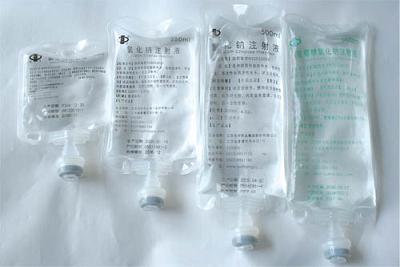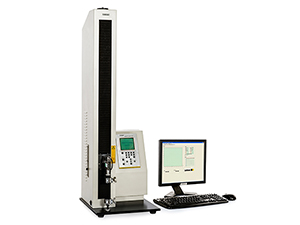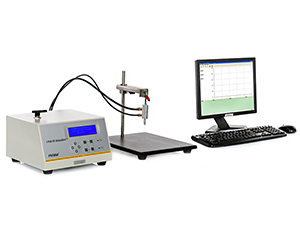Causes of Cracking of Non-PVC Composite Membrane Infusion Bag and Its Monitoring Scheme
Abstract: The non-PVC composite film infusion bag has the advantages of being able to eliminate the bacterial environment, easy to use, high gas barrier and water resistance, and environmental protection. It is an infusion packaging material that is widely favored at present. However, infusion bags of such materials often encounter cracking problems during transportation and storage, and the causes of product damage are mostly related to the material's own tensile properties or heat sealing edge effects. Therefore, reasonable testing instruments and test methods are used to monitor the tensile strength and burst pressure of the infusion bag so as to achieve effective screening. The infusion bag rupture is caused by the deterioration of the mechanical strength of the material or the edge rupture. This article uses Jinan Languang Electromechanical Technology Co., Ltd. independently developed XLW (PC) intelligent electronic tensile testing machine and LSSD-01 leakage and seal strength tester, refer to the relevant inspection standards for related industries to introduce specific monitoring programs.
Keywords: non-PVC composite membrane, infusion bag, mechanical strength, tensile strength, tensile strength, tensile properties, heat sealing effect, edge cracking, undercutting, overheating, poor heat seal, burst pressure, rupture position , Heat seal strength, leakage and seal strength tester, intelligent electronic tensile tester, pharmaceuticals, flexible plastic packaging, pharmaceutical packaging
1, detection significance
During the infusion process, from the initial open development to today's totally enclosed process, the infusion set was changed from the original glass bottle into a simple PVC soft plastic infusion bag. The material of the infusion bag is also non-environmentally friendly. The PVC material is upgraded to a non-PVC compound film soft bag that fully meets the requirements of environmental protection. The material quality of the non-PVC composite film infusion bag meets the standards of European, Japanese and United States Pharmacopoeia, has a high moisture barrier, oxygen barrier, and is suitable for the packaging of most liquid drugs. The infusion bag of this kind of material uses polypropylene (PP), polyethylene (PE), polyamide (PA) and various elastic materials (SEBS) to produce a co-extruded film by a co-extrusion process under clean conditions of class 100. Because it does not contain plasticizers and uses a co-extrusion process, waste incineration generates only water and carbon dioxide oxides and is environmentally friendly. Therefore, non-PVC composite membrane has become the main infusion bag material.
Non-PVC composite film infusion bags used in the middle and outer layers of PP, PA high density materials, in order to enhance the infusion bag on the external water vapor, oxygen barrier properties can effectively improve the mechanical strength of the infusion bag, not easy to break, easy to transport And storage. However, the proportion of PP, PE and PA in the infusion bag of such materials is not suitable or the production process is not properly operated, which may cause the mechanical strength to decrease, that is, the tensile strength and the tensile deformation rate of the bag body material are decreased, and the bag body is easily broken; If the infusion bag is in the process of heat-sealing the edges, there are problems such as "dummy sealing" due to too low heat seal strength or "hot cut" or "root breakage" due to excessive heat sealing. The infusion bag is also easy to use. Cracks in the edge seals occur during transport and storage. Therefore, the monitoring of the mechanical properties such as the toughness of the non-PVC composite membrane infusion bag and the bag body pressure resistance is very important. This article starts with the detection of tensile strength and burst pressure performance indicators, and combines the XLW (PC) intelligent electronic tensile testing machine and LSSD-01 leakage and seal strength testing instrument independently developed by Jinan Languang Electromechanical Technology Co., Ltd. The reason of the rupture of PVC composite film infusion bag and its monitoring program provide reference for the pharmaceutical industry.

Figure 1 Non-PVC composite membrane infusion bag
2, testing standards
At present, the domestic testing of infusion bag tensile strength of this performance follows YBB00112003 "Tensile Properties Test", which is a standard for the testing of tensile properties of pharmaceutical packaging.
For the test of infusion bag bursting pressure, there is no clear standard for testing methods in China. In this paper, the use of foreign ASTM F1140 "unconstraint package resistance to internal pressure damage test method" test infusion bag burst pressure to verify the location of the infusion bag is prone to rupture, and combined with the tensile strength test results to determine the rupture phenomenon is due to infusion bag pull Deterioration in stretch performance is due to seal tightness or excessive heat sealing.
3, test sample
A brand glucose infusion bag (non-PVC composite film material).
4, testing equipment
This article involves two testing equipments, namely XLW (PC) intelligent electronic tensile testing machine and LSSD-01 leaking and sealing strength testing instrument. Both testing equipments are independently developed by Jinan Languang Electromechanical Technology Co., Ltd.

Figure 2 XLW (PC) Intelligent Electronic Tensile Testing Machine

Figure 3 LSSD-01 Leakage and Sealing Strength Tester
4.1 Test principle
(1) XLW (PC) Intelligent Electronic Tensile Testing Machine
The sample is clamped between the two clamps of the clamp. The two clamps move relative to each other. Through the force sensor located on the moving clamp and the built-in displacement sensor, the force value change and displacement during the test are collected. Changes are made to calculate various mechanical properties of the sample.
(2) LSSD-01 Leakage and Sealing Strength Tester
Using the principle of positive pressure, use this instrument to pressurize the inside of the package under test until the package breaks. Pneumatic pressurizing and boosting devices have the ability to continue pressurizing to maintain a gradually increasing pressure until the package breaks. This method can detect the maximum pressure before the package breaks and determine where the package is apt to break.
4.2 Application
(1) XLW (PC) Intelligent Electronic Tensile Testing Machine
Applicable to tensile properties, tensile strength and deformation rate, tensile breaking force, heat seal strength, tear resistance, 90 degree peeling, 180 degree peeling performance testing. After special customization or fixtures, the device can also be used for infusion bag cover puncture force, soft rubber stopper, oral liquid cap puncture or drawing force, infusion bag cover pull force, tape unwind force, makeup brush, toothbrush brush pull Pulling force, sealing film tear force and other packaging, product performance testing. The instrument complies with a number of national and international standards: ISO 37, GB/T 2790, GB/T 2791, GB/T 10004, GB 8808, GB/T 1040.1 ~ GB/T 1040.4, GB/T 1040.5, QB/T 2358 , QB/T 1130, ASTM D882, ASTM D1938, ASTM D3330, YBB 00112003 and other related standards.(2) LSSD-01 Leakage and Sealing Strength Tester
Applicable to a variety of heat sealing, bonding process formed by flexible packaging, aseptic packaging and other edge sealing strength, heat sealing quality, and the whole bag burst pressure, sealing leakage performance of quantitative measurement, a variety of plastic anti-theft bottle Quantitative measurement of lid sealing performance, quantification of various hoses' overall sealing performance, compressive strength, cap connection strength, release strength, heat seal sealing strength, and tie strength; also available for flexible packaging bags Use the material's compressive strength, burst strength, and other indicators, bottle cap torque sealing index, cap connection connection strength, material stress strength, as well as the entire bottle body sealing, pressure resistance, burst resistance and other indicators for evaluation and analysis . The instrument complies with a number of national and international standards: ISO 11607-1, ISO 11607-2, GB/T 10440, GB 18454, GB 19741, GB 17447, ASTM F 1140, ASTM F 2054, GB/T 17876, GB/T 10004, BB/T 0025, QB/T 1871, YBB 00252005, YBB 001620024.3 Equipment Parameters
(1) XLW (PC) Intelligent Electronic Tensile Testing Machine
500 N, 50 N force sensor of two kinds of specifications can be chosen, the test precision is 0.5. According to relevant standards, the equipment provides seven test speeds of 50 mm/min, 100 mm/min, 150 mm/min, 200 mm/min, 250 mm/min, 300 mm/min, and 500 mm/min according to the test standard. Request freedom to set. The long stroke of 1000 mm can meet the test of large deformation rate materials. Limits protection, overload protection, automatic return, and power-down memory intelligent configuration to ensure the safety of the user's operation. A tester integrates seven independent test programs such as stretching, peeling, and tearing to provide users with a variety of test items to choose from. LystemTM laboratory data sharing system is supported to manage test results and test reports.(2) LSSD-01 Leakage and Sealing Strength Tester
Positive pressure test range of 0 to 1.6 MPa (0 to 232.1 psi) is achievable. Three sizes of 1.6 mm, 4 mm, and 10 mm inflatable heads are available. Swelling inhibition, expansion non-inhibition double test method, the user can freely choose according to different test purposes. Break test, creep test, creep to break test A variety of test modes to meet the user's different test needs. Optional test range, intelligent design of the “one-button†operation of the test process, and easy non-standard testing. LystemTM laboratory data sharing system is supported to manage test results and test reports.5, the test process
5.1 Test procedure of tensile strength index
According to the requirements of YBB00112003, five specimens of type II dumbbells were uniformly cut along the longitudinal direction of the infusion bag sample using a cutter. The sample was placed in an environment of 23 ± 2°C and 50 ± 5% RH for more than 4 hours, and tested under these conditions. Within the range of the specimen's gauge length, the thickness of three points on the specimen is measured with a measuring device with an accuracy of 0.001 mm on both the upper and lower sides, and the width of three points on the specimen is measured with a measuring device with an accuracy of 0.1 mm. Calculate the arithmetic mean. The sample is clamped between the upper and lower clamps of the tester so that the longitudinal direction of the sample coincides with the centerline of the two clamps, and the clamp is properly tightened. Set test parameters such as specimen width, test speed, initial distance between two fixtures, and specimen thickness. Click the Start Test option and the test begins. The instrument automatically records and calculates the tensile strength of the specimen. Follow steps (4) ~ (6) until all test strips have been tested. Repeat the above steps for the test method of the lateral sample.5.2 Explosion Pressure Index Test Procedure
(1) Place the infusion bag sample in an environment of 23 ± 2°C and 50 ± 5% RH for more than 48 hours.
(2) For a sealed infusion bag specimen, use a probe to pierce the bag and pressurize the bag.
(3) Select the “rupture test†method in the ASTM F1140 standard, place the fully sealed infusion bag on the LSSD-01 leak and seal strength tester , and carefully insert the booster probe into the center of the bag body .
(4) Record the position of the insertion point and make all the probe insertion holes of the tested sample in the same position.
(5) When inserting the probe, avoid puncturing the other side of the infusion bag body. If the packaging material is easily torn, adhesive tape or other equivalent means should be used to enhance the mechanical strength of the insertion point and its nearby material.
(6) Click the start button, the test begins, and inflate the bag body to inflate it. Continue to pressurize until the bag bursts.
(7) Inspect the infusion bag after the test and record the position, type, and pressure at rupture of the (bag body or seal) rupture.

Figure 4 burst pressure test process
6, test results
The burst pressures of three samples of non-PVC composite membrane infusion bags tested in this article were 80.6 KPa, 71.1 KPa, and 72.4 KPa, respectively, and all three samples broke at the root of the right side seal of the infusion bag. The average longitudinal and transverse tensile strengths of the 5 infusion bags were 35.77 MPa and 28.40 MPa, respectively. Therefore, from the results of tensile strength analysis, the tensile properties of the infusion bag sample are better. Combining with the burst pressure test results, it can be determined that the location of the infusion bag is easy to break, which is mainly located at the root of the right side sealing edge, indicating that the right side of the infusion bag is over-sealed and over-seal , easily lead to root fracture.
7. Conclusion
The rupture problem of non-PVC composite film infusion bag is a headache for the product during transportation and storage. The comprehensive test can be performed using XLW (PC) intelligent electronic tensile testing machine and LSSD-01 leakage and sealing strength tester. Verify the location of the infusion bag breakage and explore the causes to improve the breakage rate. Labthink is always committed to providing professional testing equipment and services for customers around the world. In addition to the above two testing equipment, Labthink can provide you with barrier properties, a variety of physical and mechanical properties, sanitary performance, and other categories of pharmaceutical packaging. Testing equipment, detailed information about the equipment you can visit Languang company website to view or call directly to consult. The more you understand, the more trust! Labthink expects to enhance technology exchanges and cooperation with enterprises and institutions in the industry!
Copyright Notice: The article is copyrighted by Jinan Languang Electromechanical Technology Co., Ltd.
We started to manufacture traffic signal pole from 2001 and exported from 2002.
Our firm introduced whole set of good-sized numerical control hydraulic folding equipment(1280/16000) as well as equipped with a series of good-sized professional equipments of armor plate-flatted machine, lengthways cut machine, numerical control cut machine, auto-closed up machine, auto-arc-weld machine, hydraulic redressing straight machine, etc. The firm produces all sorts of conical, pyramidal, cylindrical steel poles with production range of dia 50mm-2250mm, thickness 1mm-25mm, once taking shape 16000mm long, and large-scale steel components. The firm also is equipped with a multicolor-spayed pipelining. At the meantime, for better service to the clients, our firm founded a branch com. The Yixing Jinlei Lighting Installation Com, which offers clients a succession of service from design to manufacture and fixing.
Traffic Signal Mast,Traffic Signal Light, Camera Pole,Traffic Signal Lighting
Jiangsu Xinjinlei Steel Industry Co., Ltd. , http://www.steel-pole.com